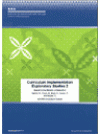Throughout the history of schooling in New Zealand the national curriculum has been revised at fairly regular intervals. Consequently, schools are periodically faced with having to accommodate to new curriculum. In between major changes other specifically-focused changes may arise; for example, the increased recent emphasis upon numeracy and literacy.
A new national curriculum represents a large undertaking for those responsible for schools and classroom teaching. The 2007 New Zealand Curriculum (Ministry of Education, 2007) is an example. It developed out of an earlier period of “rolling revision” from the 1950s to 1980s, where curriculum was revised subject-by-subject with a haphazard timeline. Change was largely led by Ministry of Education (MOE) curriculum personnel with close links to teacher unions and teachers. During the 1990s the form of revision changed. An overarching curriculum framework (Ministry of Education, 1993) outlined a design of achievement objectives organised into eight levels from Year 1 of schooling to Year 13. Content was designated through seven learning areas and a statement for each was written and promulgated through the 1990s.
By 2000 feedback from schools led the MOE to carry out a “stocktake”, resulting in approval by the Minister of Education to undertake a phase of systematic revision from 2003. A draft New Zealand Curriculum was disseminated to schools and the community in 2006 and a final document ratified by the Government for publication in late 2007 and full implementation by 2010. Some components of the 1990s curriculum statements were retained with little change. They included the design of objectives and content for eight levels over 13 years of schooling. However some major changes also emerged from all this activity. They included:
- a shift from “essential skills” to “key competencies” that integrate knowledge, skills, attitudes and values
- expanded statements on values in the curriculum
- inclusion of four future-focused themes: sustainability; citizenship; enterprise; and globalisation
- guidelines on school-based curriculum design
- a clearer vision statement
- advice on pedagogy and on assessment
- a reduction in the achievement objectives in all learning areas and the inclusion of these in one streamlined document rather than separate documents
- increased emphasis on the teaching of languages other than English.
Notwithstanding the involvement of as many people as possible in the Curriculum Project, the MOE anticipated that the scope of these changes would be challenging for many teachers and schools. It was anticipated that considerable support would be needed as each school worked towards understanding how all the changes might come together in their school setting. Accordingly, the MOE explored ways of supporting schools with implementation of the new curriculum, including “teacher-only” days for concentrated time on change, and on-line resources to support the change process. Inevitably, some school leaders were ahead of others in adopting the curriculum innovations and adapting them to meet their school’s specific needs. With the imperative for all schools to be engaged in the implementation process by 2010, the MOE determined that it would be helpful if the successful experiences of schools that got underway with the process sooner rather than later be documented, analysed for common themes and used to help determine the most productive ways to support other schools. That was the aim of the research project reported here.


